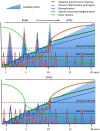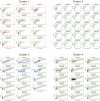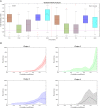Dynamics and heterogeneity of brain damage in multiple sclerosis
- PMID: 29073203
- PMCID: PMC5657613
- DOI: 10.1371/journal.pcbi.1005757
Dynamics and heterogeneity of brain damage in multiple sclerosis
Abstract
Multiple Sclerosis (MS) is an autoimmune disease driving inflammatory and degenerative processes that damage the central nervous system (CNS). However, it is not well understood how these events interact and evolve to evoke such a highly dynamic and heterogeneous disease. We established a hypothesis whereby the variability in the course of MS is driven by the very same pathogenic mechanisms responsible for the disease, the autoimmune attack on the CNS that leads to chronic inflammation, neuroaxonal degeneration and remyelination. We propose that each of these processes acts more or less severely and at different times in each of the clinical subgroups. To test this hypothesis, we developed a mathematical model that was constrained by experimental data (the expanded disability status scale [EDSS] time series) obtained from a retrospective longitudinal cohort of 66 MS patients with a long-term follow-up (up to 20 years). Moreover, we validated this model in a second prospective cohort of 120 MS patients with a three-year follow-up, for which EDSS data and brain volume time series were available. The clinical heterogeneity in the datasets was reduced by grouping the EDSS time series using an unsupervised clustering analysis. We found that by adjusting certain parameters, albeit within their biological range, the mathematical model reproduced the different disease courses, supporting the dynamic CNS damage hypothesis to explain MS heterogeneity. Our analysis suggests that the irreversible axon degeneration produced in the early stages of progressive MS is mainly due to the higher rate of myelinated axon degeneration, coupled to the lower capacity for remyelination. However, and in agreement with recent pathological studies, degeneration of chronically demyelinated axons is not a key feature that distinguishes this phenotype. Moreover, the model reveals that lower rates of axon degeneration and more rapid remyelination make relapsing MS more resilient than the progressive subtype. Therefore, our results support the hypothesis of a common pathogenesis for the different MS subtypes, even in the presence of genetic and environmental heterogeneity. Hence, MS can be considered as a single disease in which specific dynamics can provoke a variety of clinical outcomes in different patient groups. These results have important implications for the design of therapeutic interventions for MS at different stages of the disease.
Conflict of interest statement
The authors have declared that no competing interests exist.
Figures








Similar articles
-
Inflammation and degeneration in multiple sclerosis.Neurol Sci. 2003 Dec;24 Suppl 5:S265-7. doi: 10.1007/s10072-003-0170-7. Neurol Sci. 2003. PMID: 14652785 Review.
-
Disease steps in multiple sclerosis: a longitudinal study comparing disease steps and EDSS to evaluate disease progression.Mult Scler. 1999 Oct;5(5):349-54. doi: 10.1177/135245859900500508. Mult Scler. 1999. PMID: 10516779
-
Neuronal injury in chronic CNS inflammation.Best Pract Res Clin Anaesthesiol. 2010 Dec;24(4):551-62. doi: 10.1016/j.bpa.2010.11.001. Epub 2010 Nov 29. Best Pract Res Clin Anaesthesiol. 2010. PMID: 21619866 Review.
-
Brain and cord myelin water imaging: a progressive multiple sclerosis biomarker.Neuroimage Clin. 2015 Oct 3;9:574-80. doi: 10.1016/j.nicl.2015.10.002. eCollection 2015. Neuroimage Clin. 2015. PMID: 26594633 Free PMC article.
-
Clinical implications of neuropathological findings in multiple sclerosis.J Neurol. 2005 Sep;252 Suppl 3:iii10-iii14. doi: 10.1007/s00415-005-2011-5. J Neurol. 2005. PMID: 16170494 Review.
Cited by
-
Dyschromatopsia in multiple sclerosis reflects diffuse chronic neurodegeneration beyond anatomical landmarks.Acta Neurol Belg. 2021 Dec;121(6):1767-1775. doi: 10.1007/s13760-020-01516-x. Epub 2020 Oct 12. Acta Neurol Belg. 2021. PMID: 33044738
-
Reaction-diffusion models in weighted and directed connectomes.PLoS Comput Biol. 2022 Oct 28;18(10):e1010507. doi: 10.1371/journal.pcbi.1010507. eCollection 2022 Oct. PLoS Comput Biol. 2022. PMID: 36306284 Free PMC article.
-
Toxic heavy metal concentrations in multiple sclerosis patients: A systematic review and meta-analysis.EXCLI J. 2021 Nov 19;20:1571-1584. doi: 10.17179/excli2021-3484. eCollection 2021. EXCLI J. 2021. PMID: 34924905 Free PMC article. Review.
-
Tolerogenic Dendritic Cells as a Promising Antigen-Specific Therapy in the Treatment of Multiple Sclerosis and Neuromyelitis Optica From Preclinical to Clinical Trials.Front Immunol. 2018 May 31;9:1169. doi: 10.3389/fimmu.2018.01169. eCollection 2018. Front Immunol. 2018. PMID: 29904379 Free PMC article. Review.
-
Predicting disease severity in multiple sclerosis using multimodal data and machine learning.J Neurol. 2024 Mar;271(3):1133-1149. doi: 10.1007/s00415-023-12132-z. Epub 2023 Dec 22. J Neurol. 2024. PMID: 38133801 Free PMC article.
References
-
- Hauser SL, Oksenberg JR. The neurobiology of multiple sclerosis: genes, inflammation, and neurodegeneration. Neuron. 2006;52(1):61–76. doi: 10.1016/j.neuron.2006.09.011 . - DOI - PubMed
-
- Lublin FD, Reingold SC, Cohen JA, Cutter GR, Sorensen PS, Thompson AJ, et al. Defining the clinical course of multiple sclerosis: The 2013 revisions. Neurology. 2014;83(3):278–86. doi: 10.1212/WNL.0000000000000560 - DOI - PMC - PubMed
-
- Velez de Mendizabal N, Hutmacher MM, Troconiz IF, Goni J, Villoslada P, Bagnato F, et al. Predicting relapsing-remitting dynamics in multiple sclerosis using discrete distribution models: a population approach. PLoS One. 2013;8(9):e73361 doi: 10.1371/journal.pone.0073361 - DOI - PMC - PubMed
-
- Velez de Mendizabal N, Carneiro J, Sole RV, Goni J, Bragard J, Martinez-Forero I, et al. Modeling the effector—regulatory T cell cross-regulation reveals the intrinsic character of relapses in Multiple Sclerosis. BMC Syst Biol. 2011;5:114 Epub 2011/07/19. doi: 10.1186/1752-0509-5-114 - DOI - PMC - PubMed
-
- Iranzo J, Villoslada P. Autoimmunity and tumor immunology: two facets of a probabilistic immune system. BMC Syst Biol. 2014;8:120 doi: 10.1186/s12918-014-0120-4 - DOI - PMC - PubMed
MeSH terms
LinkOut - more resources
Full Text Sources
Other Literature Sources
Medical

